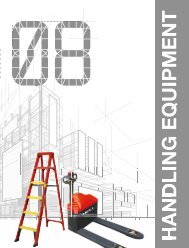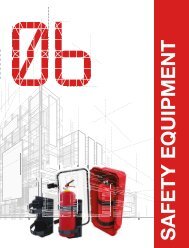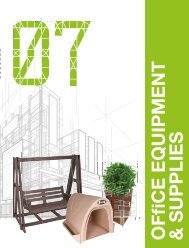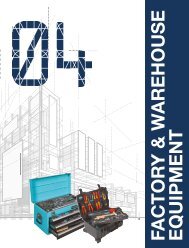Create successful ePaper yourself
Turn your PDF publications into a flip-book with our unique Google optimized e-Paper software.
THERE’S NEVER BEEN AN EASIER WAY TO ORDER PALLET RACKING!<br />
ORDER YOUR PALLET RACKING IN COMPONENT FORM OR IN COMPLETE BAYS<br />
Over the next few pages we will show you how to order pallet racking - confident in the knowledge<br />
that you will get all the right components and that it will exactly meet your requirements.<br />
Option 1. Order in component form - this has the advantage that you have more combinations of<br />
components to choose from, allowing you slightly more versatility in your pallet racking design.<br />
SHELVING AND RACKING<br />
Option 2. The easiest of all options (shown overleaf) - is to simply choose the size you need and<br />
order from the standard bay sizes shown.<br />
1. HOW TO CALCULATE THE SIZE YOU NEED?<br />
The first thing to do when ordering pallet racking is to decide which frame depth and beam<br />
width you need together with the height. This will depend upon the type and size of pallet you<br />
wish to store.<br />
Pallet racking has infinite style variations and any product can be stored and a number of<br />
picking options are available which we will explain as you look further through this section<br />
However there are two pallet sizes that are used far more than any other:<br />
1200mm wide x 1000mm deep pallets or 800mm wide x 1200mm deep often<br />
referred to as ‘europallets’. These two sizes are fast becoming the industry standard, and<br />
this section generally concentrates on the storage of these two sizes.<br />
2. WHAT HEIGHT DO YOU NEED?<br />
The height of the pallet racking will depend upon a few factors:<br />
What height pallets you need to store? - How high is your storage area and how high does your<br />
fork truck reach and at what safety level?.<br />
Remember that with the first beam level being no more than 1500mm from the floor a full<br />
bay will accept a maximum of 8000kg. (UDL) so this weight needs to be calculated for the<br />
number of pallets you intend to place into each bay. Once these are decided it is generally most<br />
effective to go as high as possible.<br />
q Shown below are the two most popular pallet sizes used within industry<br />
Uprights are available in 3.0m, 3.6m, 4.2m, 5.4m, 6.0m, 6.6m, 7.2m OR 7.8m<br />
OPTIONS.<br />
3. CHOOSING YOUR BEAMS<br />
Again the depth and width of the pallet racking bay will be determined by the size of pallet and<br />
the way in which you wish to load it into the bay.<br />
<br />
The width of each pallet racking bay can have a clear entry of<br />
1219 1524, 1829, 2134, 2438, 2743, 3048, 3353, 3658mm<br />
depending on the beams you choose.<br />
When calculating the number of pallets per pair of beams you need to take into<br />
consideration<br />
• The weight of the pallet to be stored<br />
• The operating requirement for a 75mm clearance<br />
between a pallet and the frame and a minimum of<br />
75mm clearance between each pallet. This has<br />
already been allowed for in all the examples shown on<br />
these pages depending on the beams you choose.<br />
q The beams suitable for these pallets<br />
are shown here<br />
C<br />
B<br />
A<br />
B<br />
C<br />
C<br />
A<br />
B<br />
C<br />
800mm wide x 1200mm deep (euro pallet)<br />
1200mm wide x 1000mm deep pallets (fork entry at 1200)<br />
1200mm wide x 1000mm deep pallets (fork entry at 1000)<br />
Which size you use will determine the width and depth of the racking you will need. The depth of the frame has been designed to allow<br />
for the pallet overhang and distribution of weight.<br />
Important Safety aspects:<br />
• To be sure of adequate rigidity and safety, you must use at least 2 beam levels per bay and a minimum run of two<br />
bays.<br />
• Each bay has a maximum loading of up to 8000kg, it is important that you calculate the total weight of pallets in<br />
each bay<br />
to ensure the maximum loading capacity isn’t exceeded.<br />
• Please check that the pallets used are in good condition and are suitably designed to be stored within a pallet<br />
racking system.<br />
• All frames should be firmly secured using floor anchors.<br />
• We would recommend high level access equipment on all installations exceeding 6000mm.<br />
B<br />
A<br />
124<br />
www.storagedirect.co.za<br />
Prices are subject to fluctuation – All prices exclude VAT

















